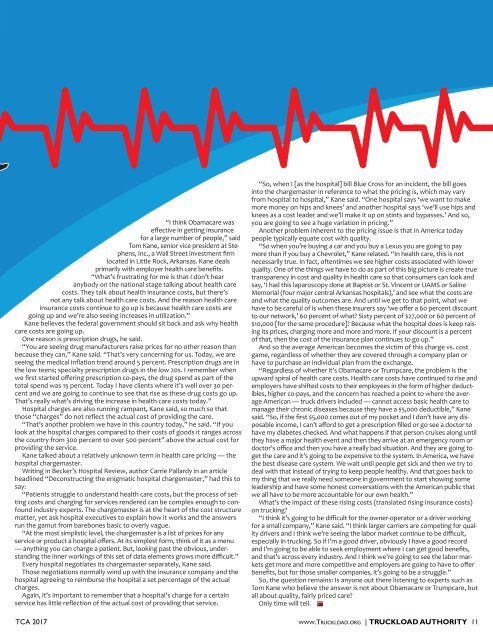TLA25_AllPages_R
Create successful ePaper yourself
Turn your PDF publications into a flip-book with our unique Google optimized e-Paper software.
“I think Obamacare was<br />
effective in getting insurance<br />
for a large number of people,” said<br />
Tom Kane, senior vice president at Stephens,<br />
Inc., a Wall Street investment firm<br />
located in Little Rock, Arkansas. Kane deals<br />
primarily with employer health care benefits.<br />
“What’s frustrating for me is that I don’t hear<br />
anybody on the national stage talking about health care<br />
costs. They talk about health insurance costs, but there’s<br />
not any talk about health care costs. And the reason health care<br />
insurance costs continue to go up is because health care costs are<br />
going up and we’re also seeing increases in utilization.”<br />
Kane believes the federal government should sit back and ask why health<br />
care costs are going up.<br />
One reason is prescription drugs, he said.<br />
“You are seeing drug manufacturers raise prices for no other reason than<br />
because they can,” Kane said. “That’s very concerning for us. Today, we are<br />
seeing the medical inflation trend around 5 percent. Prescription drugs are in<br />
the low teens; specialty prescription drugs in the low 20s. I remember when<br />
we first started offering prescription co-pays, the drug spend as part of the<br />
total spend was 15 percent. Today I have clients where it’s well over 30 percent<br />
and we are going to continue to see that rise as these drug costs go up.<br />
That’s really what’s driving the increase in health care costs today.”<br />
Hospital charges are also running rampant, Kane said, so much so that<br />
those “charges” do not reflect the actual cost of providing the care.<br />
“That’s another problem we have in this country today,” he said. “If you<br />
look at the hospital charges compared to their costs of goods it ranges across<br />
the country from 300 percent to over 500 percent” above the actual cost for<br />
providing the service.<br />
Kane talked about a relatively unknown term in health care pricing — the<br />
hospital chargemaster.<br />
Writing in Becker’s Hospital Review, author Carrie Pallardy in an article<br />
headlined “Deconstructing the enigmatic hospital chargemaster,” had this to<br />
say:<br />
“Patients struggle to understand health care costs, but the process of setting<br />
costs and charging for services rendered can be complex enough to confound<br />
industry experts. The chargemaster is at the heart of the cost structure<br />
matter, yet ask hospital executives to explain how it works and the answers<br />
run the gamut from barebones basic to overly vague.<br />
“At the most simplistic level, the chargemaster is a list of prices for any<br />
service or product a hospital offers. At its simplest form, think of it as a menu<br />
— anything you can charge a patient. But, looking past the obvious, understanding<br />
the inner workings of this set of data elements grows more difficult.”<br />
Every hospital negotiates its chargemaster separately, Kane said.<br />
Those negotiations normally wind up with the insurance company and the<br />
hospital agreeing to reimburse the hospital a set percentage of the actual<br />
charges.<br />
Again, it’s important to remember that a hospital’s charge for a certain<br />
service has little reflection of the actual cost of providing that service.<br />
“So, when I [as the hospital] bill Blue Cross for an incident, the bill goes<br />
into the chargemaster in reference to what the pricing is, which may vary<br />
from hospital to hospital,” Kane said. “One hospital says ‘we want to make<br />
more money on hips and knees’ and another hospital says ‘we’ll use hips and<br />
knees as a cost leader and we’ll make it up on stints and bypasses.’ And so,<br />
you are going to see a huge variation in pricing.”<br />
Another problem inherent to the pricing issue is that in America today<br />
people typically equate cost with quality.<br />
“So when you’re buying a car and you buy a Lexus you are going to pay<br />
more than if you buy a Chevrolet,” Kane related. “In health care, this is not<br />
necessarily true. In fact, oftentimes we see higher costs associated with lower<br />
quality. One of the things we have to do as part of this big picture is create true<br />
transparency in cost and quality in health care so that consumers can look and<br />
say, ‘I had this laparoscopy done at Baptist or St. Vincent or UAMS or Saline<br />
Memorial (four major central Arkansas hospitals),’ and see what the costs are<br />
and what the quality outcomes are. And until we get to that point, what we<br />
have to be careful of is when these insurers say ‘we offer a 60 percent discount<br />
to our network,’ 60 percent of what? Sixty percent of $27,000 or 60 percent of<br />
$10,000 [for the same procedure]? Because what the hospital does is keep raising<br />
its prices, charging more and more and more. If your discount is a percent<br />
of that, then the cost of the insurance plan continues to go up.”<br />
And so the average American becomes the victim of this charge vs. cost<br />
game, regardless of whether they are covered through a company plan or<br />
have to purchase an individual plan from the exchange.<br />
“Regardless of whether it’s Obamacare or Trumpcare, the problem is the<br />
upward spiral of health care costs. Health care costs have continued to rise and<br />
employers have shifted costs to their employees in the form of higher deductibles,<br />
higher co-pays, and the concern has reached a point to where the average<br />
American — truck drivers included — cannot access basic health care to<br />
manage their chronic diseases because they have a $5,000 deductible,” Kane<br />
said. “So, if the first $5,000 comes out of my pocket and I don’t have any disposable<br />
income, I can’t afford to get a prescription filled or go see a doctor to<br />
have my diabetes checked. And what happens if that person cruises along until<br />
they have a major health event and then they arrive at an emergency room or<br />
doctor’s office and then you have a really bad situation. And they are going to<br />
get the care and it’s going to be expensive to the system. In America, we have<br />
the best disease care system. We wait until people get sick and then we try to<br />
deal with that instead of trying to keep people healthy. And that goes back to<br />
my thing that we really need someone in government to start showing some<br />
leadership and have some honest conversations with the American public that<br />
we all have to be more accountable for our own health.”<br />
What’s the impact of these rising costs (translated rising insurance costs)<br />
on trucking?<br />
“I think it’s going to be difficult for the owner-operator or a driver working<br />
for a small company,” Kane said. “I think larger carriers are competing for quality<br />
drivers and I think we’re seeing the labor market continue to be difficult,<br />
especially in trucking. So if I’m a good driver, obviously I have a good record<br />
and I’m going to be able to seek employment where I can get good benefits,<br />
and that’s across every industry. And I think we’re going to see the labor markets<br />
get more and more competitive and employers are going to have to offer<br />
benefits, but for those smaller companies, it’s going to be a struggle.”<br />
So, the question remains: Is anyone out there listening to experts such as<br />
Tom Kane who believe the answer is not about Obamacare or Trumpcare, but<br />
all about quality, fairly priced care?<br />
Only time will tell.<br />
TCA 2017 www.Truckload.org | Truckload Authority 11

















